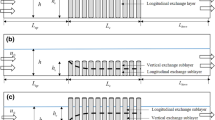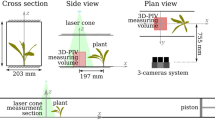Abstract
This contribution presents particle image velocimetry measurements for an open channel stationary uniform and fully developed flow of water over a horizontal flat bed of uniform glass beads in presence of a staggered array of vertical cylindrical stems. The main objective was to explore and quantify the influence of the stems-to-flow relative submergence, h v /h, over the mean flow and local turbulence intensities. A comparison with measurements for the non-vegetated flow over the same granular bed is presented. Results indicate a remarkable influence of h v /h over the whole flow field. The time-average mean flow presents a strong spatial variation in the layer of the flow occupied by the stems. The local velocity fluctuations are strongly affected by the presence of the stems, with regions in between the stems where they reach peaks that are several times larger than those encountered in the flow in absence of vegetation. The turbulence intensity profiles are noticeably different when compared to those measured in the non-vegetated flow conditions. From previous works it was possible to derive an equation for the mean velocity, U v , of the flow through the vegetated layer of height h v . The prediction of this equation is in good agreement with the uniform value for the double-average longitudinal velocity profile in this layer. A final brief discussion about the possible impact of these vegetated-flow features on the sediment transport is presented.
Similar content being viewed by others
References
Järvelä J (2006) Flow sediment vegetation interaction: research challenges, river flow 2006. Taylor and Francis Group, London
Salvia M (2009) Estimating flow resistance of wetlands using SAR images and interaction models. Remote Sens 1: 992–1008
Major sediment issues confronting the Bureau of Reclamation and Research Needs Towards Resolving These Issues, Proceedings of the U.S. Geological Survey (USGS) Sediment Workshop (1997) In: Yang CT, Young, CA (eds) U.S. Bureau of Reclamation: Riparian vegetation and its effect on bed roughness and controlling channel width and soil erosion. It is necessary to quantify the effects of friction losses in flows through flexible and rigid vegetation. What are the effects of vegetation to bank erosion rates and to the onset of sediment transport? Harpers Ferry, West Virginia, US
Le Hir P (2007) Sediment erodability in sediment transport modelling: Can we account for biota effects?. Cont Shelf Res 27: 1116–1142
López F (2001) Mean flow and turbulence structure of open-channel flow through non-emergent vegetation. J Hydraul Eng 127(5): 392–402
Neary VS (2003) Numerical solution of fully developed flow with vegetative resistance. J Hydraul Eng 129(5): 558–563
Yen BC (2002) Open channel flow resistance. J Hydraul Eng 128(1): 20–39
Nikora V (2004) Velocity distribution in the roughness layer of rough-bed flows. J Hydraul Eng 130(10): 1036–1042
Manes C (2007) Double-averaged open-channel flows with small relative submergence. J Hydraul Eng 133(8): 896–904
Stone BM, Shen HT (2002) Hydraulic resistance of flow in channels with cylindrical roughness. J Hydraul Eng 128(5): 500–506
Carollo FG (2002) Flow velocity measurements in vegetated channels. J Hydraul Eng 128(7): 664–673
Poggi D (2004) The effect of vegetation density on canopy sub-layer turbulence. Bound Layer Meteorol 111(6): 565–587
Huthoff F (2007) Analytical solution of the depth-averaged flow velocity in case of submerged rigid cylindrical vegetation. Water Resour Res 43: W06413
Baptist MJ (2007) On inducing equations for vegetation resistance. J Hydraul Res 45(4): 435–450
Nepf HM (2000) Flow structure in depth-limited, vegetated flow. J Geophys Res 105(12): 28547–28557
Nepf HM (2006) The structure of the shear layer in flows over rigid and flexible canopies. Environ Fluid Mech 6: 277–301
Klopstra D (1997) Analytical model for hydraulic roughness of submerged vegetation, 27th Congress of the International Association for Hydraulic Research, San Francisco, California, US, pp 775–780. ASCE, ISBN 90-77051-03-1
Garcia MH (2004) Flow, turbulence and resistance in a flume with simulated vegetation, Riparian vegetation and fluvial geomorphology. In: Bennet SJ, Simon A (eds) (eds) Water science and application 8. AGU, Washington
White FM (1979) Mecánica de Fluidos, 652. McGraw-Hill, México
Raffel M, Willert C, Kompenhans J (2000) Particle image velocimetry: a practical guide. Springer-Verlag, Berlin
Adrian RJ (1997) Dynamic ranges of velocity and spatial resolution of particle image velocimetry. Meas Sci Technol 8: 1393–1398
Adrian RJ (2004) Twenty years of paricle image velocimetry, 12th International symposium on applications of laser techniques to fluid mechanics. Lisbon, Portugal
Olsen MG (2001) Measurement volume defined by peak-finding algorithms in cross-correlation particle image velocimetry. Meas Sci Technol 12: 14–16
Prasad A (2000) Particle image velocimetry. Curr Sci 79(1): 51–60
Westerweel J (1997) Fundamentals of digital particle image velocimetry. Meas Sci Technol 8: 1379–1392
Melling A (1997) Tracer particles and seeding for particle image velocimetry. Meas Sci Technol 8: 1406–1416
Stanislas M (1997) Practical aspects of image recording in particle image velocimetry. Meas Sci Technol 8: 1417–1426
Huang H (1997) On errors of digital particle image velocimetry. Meas Sci Technol 8: 1427–1440
Nogueira J (1997) Data validation, false vectors correction and derived magnitudes calculation on PIV data. Meas Sci Technol 8: 1493–1501
Jakobsen ML (1997) Particle image velocimetry for predictions of acceleration fields and force within fluid flows. Meas Sci Technol 8: 1502–1516
Acheson DJ (1990) Elementary fluid dynamics. Oxford University Press, Oxford
Gurka R (1999) Computation of pressure distribution using PIV velocity data, 3rd International workshop on particle image velocimetry, California
Zanke UCE (2003) On the influence of turbulence on the initiation of sediment motion. Int J Sediment Res 18(1): 17–31
Dey S (2008) Sediment threshold under stream flow: a state-of-the-art review. Water Eng 12(1): 45–60
Coleman SE (2008) A unifying framework for particle entrainment. Water Resour Res 44, W04415 1-10
Valyrakis M (2010) Role of instantaneous force magnitude and duration on particle entrainment. J Geophys Res 115, F02006 1-18
Jordanova AA, James CS (2003) Experimental study of bed load transport through emergent vegetation. J Hydraul Eng 129(6): 474–478
Meijer DG, Van Velzen EH (1999) Prototype-scale flume experiments on hydraulic roughness of submerged vegetation. 28th IAHR Congress (1999), Graz, Austria
Author information
Authors and Affiliations
Corresponding author
Rights and permissions
About this article
Cite this article
Martino, R., Paterson, A. & Piva, M. Double-average mean flow and local turbulence intensity profiles from PIV measurements for an open channel flow with rigid vegetation. Environ Fluid Mech 12, 45–62 (2012). https://doi.org/10.1007/s10652-011-9221-4
Received:
Accepted:
Published:
Issue Date:
DOI: https://doi.org/10.1007/s10652-011-9221-4




